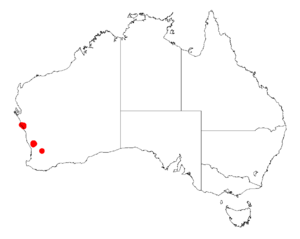Acacia ridleyana facts for kids
Quick facts for kids Acacia ridleyana |
|
|---|---|
| Conservation status | |
| Scientific classification | |
| Genus: |
Acacia
|
| Species: |
ridleyana
|
 |
|
| Occurrence data from AVH | |
The Acacia ridleyana is a type of shrub that belongs to the Acacia plant family. It is a special plant because it grows naturally only in a specific part of western Australia. This means it is endemic to that area.
About the Plant
This shrub usually spreads out and grows to be about 0.2 to 0.9 meters (which is about 0.6 to 3 feet) tall. Its small branches are a bit hairy. It has tiny, narrow, triangular parts called stipules that stay on the plant, growing up to about 2.5 millimeters long.
Like many Acacia plants, it doesn't have regular leaves. Instead, it has phyllodes. These are flattened leaf stems that look and act like leaves. The phyllodes of Acacia ridleyana are tough and stay green all year. They are shaped like a narrow rectangle or a spoon, often curving like an "S." Each phyllode is about 12 to 25 millimeters long and 2 to 3.5 millimeters wide. They have three strong, raised lines on each side.
The plant blooms from August to December, showing off bright yellow flowers. Its simple flower clusters grow one by one where the leaves meet the stem (this spot is called the axil). Each cluster forms a round ball of flowers, about 5 to 7 millimeters across, with 16 to 30 golden-colored flowers.
After the flowers, the plant grows seed pods. These pods are firm, tough, and curved. They are shaped like a flattened tube, up to 5.5 centimeters long and 3.5 to 4 millimeters wide. They have lines running along their length.
Where It Grows
Acacia ridleyana is found in different, spread-out spots across the Wheatbelt and Mid West areas of Western Australia. It likes to grow in clay, loamy (a mix of sand, silt, and clay), or sandy soils.
You can find this plant from the Murchison River in the north, stretching down to a town called Northampton in the south. There's also another group of these plants found even further south, near the Mogumber Nature Reserve. It usually grows as part of heathland communities, which are areas with low-growing shrubs.


